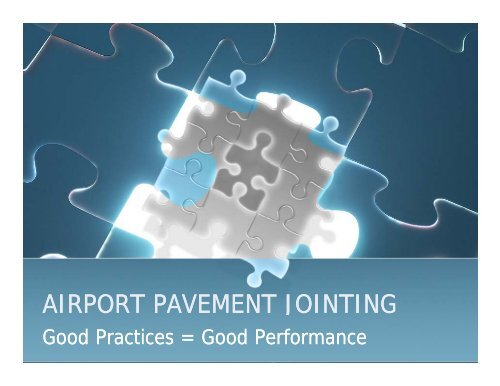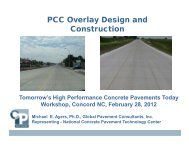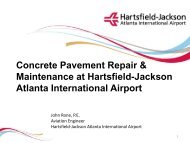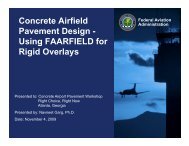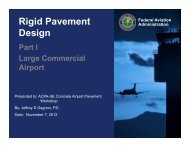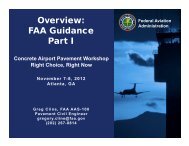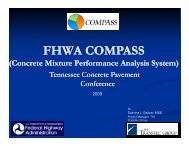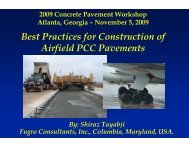airport pavement jointing - American Concrete Pavement Association
airport pavement jointing - American Concrete Pavement Association
airport pavement jointing - American Concrete Pavement Association
Create successful ePaper yourself
Turn your PDF publications into a flip-book with our unique Google optimized e-Paper software.
AIRPORT PAVEMENT JOINTINGGood Practices = Good Performance
Airport <strong>Pavement</strong> JointingGreg DeanDirector of Airports<strong>American</strong> <strong>Concrete</strong> <strong>Pavement</strong> <strong>Association</strong>Southeast ChapterGDEAN@PAVEMENTSE.COM919.772.6648www.<strong>pavement</strong>se.comOctober 21, 2008
A Cost-Effective <strong>Pavement</strong>That Meets / ExceedsAnticipated Design Life
Over-Designing is not the answerMore is not always better…• Extra Thickness• Extra Strength• Extra Reinforcement or Dowels• Extra Base (Depth or Strength)Good Jointing practices will lead to goodperformance
Less than 1 year Old…Design Issue?Construction Issue?Combination?
Good Designs = Good PerformanceConstructed in 1953PCI = 97Brunswick – Golden Isles
Good Designs = Good Performance<strong>Concrete</strong> vs. AsphaltForty years older than AsphaltBQK <strong>Pavement</strong> Performance ComparisonAsphalt<strong>Concrete</strong>PC CI Rating1009080706050403020100979695 96.497067.8364Apron RW TW Total
Why the difference?McKinnon – St. Simons IslandApron PCI = 20Shattered slabs
Performance – Why thedifference?• Similar Materials• Similar Thickness (10”)• Similar Base (stabilized)• Similar il LoadingPCI = 9712.5 x 15 feetVery differentJointing PatternPCI = 20~ 25 feet
Principles of DesignLoad stressTCurling and WarpingVolume ChangeJointSpacing
Jointing Purpose• Limit slab stress• Construction increments• Allow slab movement• Provide load transfer• Provide crack that can be maintained
Crack Formation-3/8 in.100 ftDrying Shrinkage-3/8 in.Thermal ContractionRestraintRestraintCurling/Warping± 20 ft
Shrinkage (cycle)Curling: caused by temperature gradientWarping: caused by moisture gradientCool Top/dryingWarm Top/wetting
What Causes Curling?DayTensionCoolHotWeight of slabNightCompression
Crack Formation-3/8 in.100 ftDrying Shrinkage-3/8 in.Thermal ContractionRestraintRestraintCurling/Warping± 20 ft
Where Does Restraint Come• SubbaseFrom?• Friction (higher the stiffness > restraint)• Unevenness• Voids• Slab edges (fill-in lanes)• Friction• Dowel bars or tiebars
Solution is Controlled Cracks(Joints)• Spacing & type• Vertical work• Thickness• Shrinkage• Load transfer req’t• Steel content• Base material(<strong>pavement</strong>s)• EOR specify jointlocation/type• <strong>Pavement</strong>s• Specify spacing &type but be flexibleof location• Depends onconstruction methods
Considerations for Jointing• Joint Spacing• Joint Type• Dowels• Sealing
FAA Maximum Joint SpacingSlab ThicknessTrans.Long.60 6.07.0-9.09.0-12.0>12.0inch12.512.515.0 15.020.0 20.025.0 25.0feetFAA AC 150/5320-6D Table 3-11
Stabilized or OverlayML = T x CSSlab ThicknessTrans.Long.60 6.08.010.0>12.0inchMax10.00 12.512.5 12.515.0 12.520.0 20.0feetML = Max. Length between jointsT = Slab ThicknessCS = Support Constant• Use 24 for granular subbases• Use 21 for stabilized oroverlays
Joint Types• Contraction (Shrinkage or Control)• Construction
Contraction Joints
Contraction Joint DetailsDoweledPlain
Jointing Begins With A SawcutGranular SubbaseStabilized Subbase• T/4 Saw Depth• T/3 Saw Depth• Bond BreakerOther Considerations:• Saw Timing• <strong>Concrete</strong> AggregateLimestoneSiliceous GravelTemperature Sensitivity
DoweledConstructionJoints
Construction JointSmooth DowelSeal ReservoirT/2TSmooth Face (Butt Joint)
Dowel Hole Gang Drill
Doweled Contraction JointsDoweled
Airport Dowel DimensionsSlab Thickness Dia. Length. Space6.0-7.080-12 8.0 12.013.0-16.017.0-20.0021.0-24.0inches0.7510 1.01.25150 1.502.0018.018.020.020.0024.0inches12.012.015.018.018.0
Where to Use Dowels...• Longitudinal construction Joints• Certain transverse expansion joints• Last 3 transverse contraction ti jointsfrom free edge (i.e. runway ends)AC 150/5320-6D339. Jointing Steel: Where used. Provisions for loadtransfer by dowels is provided at all transverse expansionjoints and all butt-type construction joints. Dowels forcontraction c o joints should be provided at least three jointsfrom free edge. Contraction joints in the interior may be thedummy groove type (type H).
Isolation/Expansion JointsDoweledCapThickenedEdge1.25TFiller
Isolation Joints• Separate <strong>pavement</strong> segments ofdissimilar movement (axis)• use bird’s eye view• Where future <strong>pavement</strong> might beexpected• At <strong>Pavement</strong> Penetrations
Where to Isolate...DifferentMovementAxis
<strong>Pavement</strong> Penetrations
Filets...
Filet DetailsThickened Edge JointPerpendicularto edge2 ftOptional Location
Odd-shaped Panels in Filets• Add steel reinforcement (mesh)• 0.05% by cross-section in bothdirections minimum
Fillet Details
Joint Layout PatternConnectorIsolationDoweled ContractionDoweled ConstructiontiRunwayContractionTaxiway
Don’ts
Construction Joint DetailsSeal ReservoirKeyedT/2TFAA AC/150-5320-6D - Do not use for <strong>pavement</strong>FAA AC/150 5320 6D Do not use for <strong>pavement</strong>less than 9-inches. Not recommended for use at<strong>airport</strong>s with wide-body traffic.
Bad Male Keyways
Don’t bringa joint tothe edgeof<strong>pavement</strong>on anangle
Don’tplacebars tooclosetogether!
Don’tdrill adowelhole intoanotherjointface
Summary• Watch your panel size (smaller isbetter)…especially with stiffer, highfriction support/bases• Ideally, be square• Keep ratio (slab L : slab W) to 125%• Look for opportunities to optimize:• Paving lane widths…be flexible• Aggregate interlock has provenperformance for airfield <strong>pavement</strong>s
Thank YOUGREG DEANDirector of Airports<strong>American</strong> <strong>Concrete</strong> <strong>Pavement</strong> <strong>Association</strong>Southeast ChapterGDEAN@PAVEMENTSE.COM919 772 919.772.6648www.<strong>pavement</strong>se.com
Temp Effects on VolumeChangeTemperaturePlastic Autogenous DryingEvaporation Emptying py of Capillaries DryingTime
Load stresses in rigid<strong>pavement</strong>• Temperature• Creep & Shrinkage• Curling & warping• TrafficTraffic LoaddyEh23 2M = EIM =22dx12 (1 − μ2 )dxMoment – CurvatureEquivalent to(Beam)Moment – Curvature(Slab)dw
W3l2l1ll=4Eh3212 (1 − μ)k


